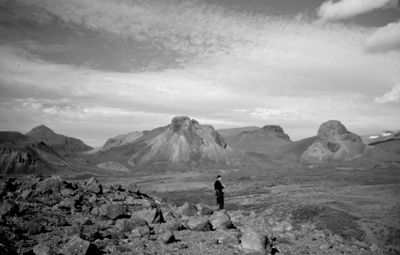Introducing GEMOC
MISSION
- to create a new paradigm for the formation of metallogenic provinces by undertaking fundamental research on the evolution of the upper 200 km of the Earth's crust-mantle system, integrating petrological, geochemical and geophysical information
- to give the Australian minerals exploration industry a competitive edge into the 21st century by transferring this new knowledge base and the methodologies to the industry and to the next generation of students
BACKGROUND
The National Key Centre for the Geochemical Evolution and Metallogeny of Continents (GEMOC) formally commenced in January, 1996. Funding started from July 1995 on very short notice, so GEMOC is operating on a 6-month delay with fund rollover. GEMOC was based on the existing expertise and strong funding profile (dominantly ARC) of groups at Macquarie and ANU (Faculties), with collaborative links to CSIRO, AGSO and colleagues at other Australian Universities as detailed under "Participants" in Appendix 1. GEMOC has diversified from this base with shifts in linkages, especially the formation of strong new collaborative programs nationally and internationally across the core activities of GEMOC.
The main targets of GEMOC's activities are large-scale problems related to lithosphere evolution and understanding the relevance of different types of crust-mantle domains to area selection for mineral exploration.
Major strengths are the diversity of the individual strands that relate to this focus, crossing conventional subdiscipline boundaries, and the range of scales being used in an integrated way to interpret fundamental Earth processes. The scales range from global, to regional, to outcrop, to the micron.
The front cover for the 1999 Report emphasises the novel developments in microbeam analysis that allow us to map lithospheric domains and track the time and nature of crust-mantle interaction by dating zones in single zircon crystals and their Hf isotopic composition. Parallel advances in the integration of geophysical and geochemical information to image the lithosphere and its properties continue to be driven by end-user needs and the knowledge required to solve major geological problems.
SCIENTIFIC PHILOSOPHY
GEMOC's distinctiveness lies in its interdisciplinary and integrated approach to interpreting Earth's lithosphere as a 4-dimensional dynamic system (in space and time).
This approach links petrology and geochemistry
geophysics
petrophysics
tectonics within the important contexts of time (4th dimension)
thermal state to understand the significance of large-scale mantle and crustal domains and the processes that have formed and modified them.
STRATEGIC OUTCOMES
- fundamental insights into the processes that create and modify the continental mantle and crust through time
- a better understanding of the assembly of the Australian continent and its geological architecture to 100-200 km depth through work in Australia and global analogues
- results and concepts exportable to other terrains, including Southeast Asia and other potentially resource-rich areas of interest to Australian exploration companies
- a new conceptual framework for understanding the localisation of economic deposits, which will influence exploration strategies for world-class ore deposits, and improve the competitiveness of the Australian exploration industry both on- and off-shore
- a realistic 3-D geological framework for the interpretation of lithospheric-scale geophysical datasets
- a training program for senior undergraduate and postgraduate students (and continuing education) that will help maintain the technological edge of the Australian mineral industry and improve the industry's ability to rapidly assimilate new concepts and methodologies
- new analytical strategies for determining the chemical and isotopic compositions of geological materials (including fluids)
- development of in situ analytical methods (including dating) to maximise information encoded in mineral zoning and to enhance interpretation of data using spatial contexts
- strategic and collaborative alliances with technology manufacturers in design and application innovation
- International research, teaching, industry and technology links of benefit to Australia

Are Oceanic Plateaux nascent continents? The nature of the lithosphere beneath the Kerguelen Islands is one of GEMOC's project strands linking the Lithosphere Mapping, Crustal Evolution and Geotectonics Research Programs. The Kerguelen Project is a major collaborative venture with the University of St Etienne, France (within the FrenchSub-Antarctic Program) and is also an active part of GEMOC's teaching and training program with the involvement of three postgraduate students.
Plaine de Dante, Kerguelen, January 1999

 GEMOC ARC National Key Centre
GEMOC ARC National Key Centre